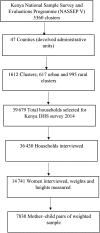The double burden of overnutrition and undernutrition in mother-child dyads in Kenya: demographic and health survey data, 2014
- PMID: 32042413
- PMCID: PMC6984123
- DOI: 10.1017/jns.2019.39
The double burden of overnutrition and undernutrition in mother-child dyads in Kenya: demographic and health survey data, 2014
Abstract
The double burden of overnutrition and undernutrition is rapidly becoming a public health concern in low- and middle-income countries. We explored the occurrence of mother-child pairs of over- and undernutrition and the contributing factors using the 2014 Kenya Demographic and Health Survey data. A weighted sample of 7830 mother-child pairs was analysed. The children's nutritional status was determined using the WHO 2006 reference standards while maternal nutritional status was determined with BMI. Descriptive statistics, bivariate and multivariate logistic regression analysis were conducted. The proportion of overweight and obese mothers was 26 % (18·8 % overweight and 7·2 % obese). The prevalence of child stunting, underweight and wasting was 26·3, 12·8 and 5·1 %, respectively. Out of the overweight/obese mothers (weighted n 2034), 20 % had stunted children, 5·4 % underweight children and 3·1 % wasted children. Overweight/obese mother-stunted child pairs and overweight/obese mother-underweight child pairs were less likely to occur in the rural areas (adjusted OR (aOR) = 0·43; P < 0·01) in comparison with those residing in the urban areas (aOR = 0·54; P = 0·01). Children aged more than 6 months were more likely to be in the double burden dyads compared with children below 6 months of age (P < 0·01). The double burden mother-child dyads were more likely to be observed in wealthier households. Mother-child double burden is a notable public health problem in Kenya. Household wealth and urban residence are determinants of the double burden. There is need for target-specific interventions to simultaneously address child undernutrition and maternal overweight/obesity.
Keywords: DHS, Demographic and Health Survey; Demographic health survey; Double burden; KDHS, Kenya Demographic and Health Survey; Kenya; Mother−child pairs; Overnutrition; Undernutrition; aOR, adjusted OR.
© The Author(s) 2020.
Figures


References
-
- Doak CM, Adair LS, Bentley M, et al. (2005) The dual burden household and the nutrition transition paradox. Int J Obes (Lond) 29, 129–136. - PubMed
-
- Black RE, Victora CG, Walker SP, et al. (2013) Maternal and child undernutrition and overweight in low-income and middle-income countries. Lancet 382, 427–451. - PubMed
-
- Khan SH & Talukder SH (2013) Nutrition transition in Bangladesh: is the country ready for this double burden. Obes Rev 14, Suppl. 2, 126–133. - PubMed
MeSH terms
LinkOut - more resources
Full Text Sources
Medical

